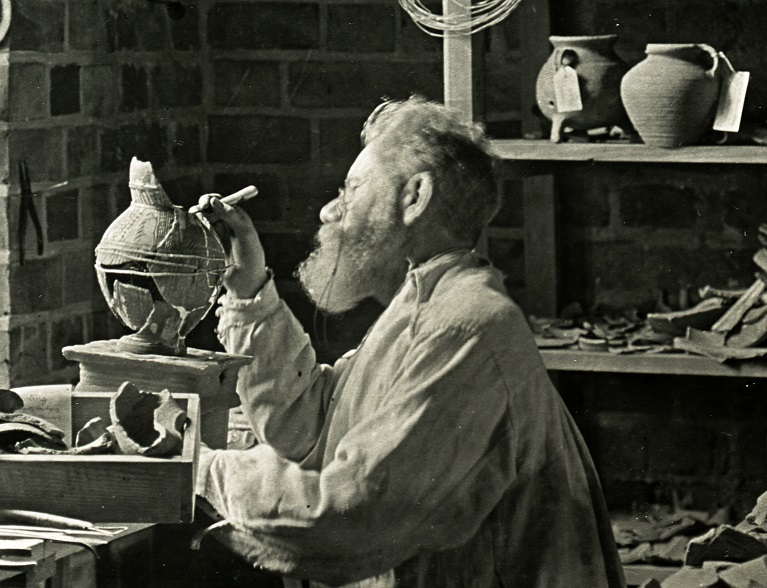Carl Kuhnd was born in 1853 in Rudolstadt, Thuringia. He studied drawing and modeling at the professional Royal School of Design and Modeling (German: Königliche Schule für Modellieren, Ornament- und Musterzeichnen), which operated in the years 1839–1881 in Dresden. He also continued his apprenticeship in Munich, but it is not known in what institution or workshop. In 1886 he started his professional career in Malborska Cegielnia and Fabryka Wyrobów Ceramicznych in Kałdów (German: Marienburger Ziegelei- und Thon-Waaren-Fabrik). In the years 1886–1900 he was involved in designing, modeling and molding works for the needs of the castle in Malbork restoration.
His workshop in a brickyard created many prototypes of profile bricks, brackets, bases and capitals of some columns of the jambs of the cloister’s slides, as well as letter bricks, details with mask motifs with grotesque grimaces and interesting, almost fully-plastic solutions of figural scenes on some capitals of the columns (Fig. 1) ). He was also involved in joining dismembered, ceramic artifacts on plaster (Fig. 2). His last documented ceramic work was an inscription made of letter bricks, which was placed in 1913 on the eastern facade of the Woodcarving Gate.
In all his work the design, modeling and molding works became only an episode in the artist’s long professional life, despite his professional preparation, because he devoted most of his time to photography. Initially, in the years 1890–1898 he helped photographer Ferdinand Peter Schwarz in photographs for subsequent construction albums (German: Marienburg Baujahr). In this way, he got to know the equipment and explored the secrets of the photographic darkroom. For subsequent albums, he has already started to make his first photos on glass plates in the 13 x 18 cm format, then duplicating a dozen of their prints (so-called contact sheets).
When in 1900 Schwarz resigned from cooperation for personal reasons with the Castle Reconstruction Authority in Malbork, Kuhnd took the place of the main castle photographer. In 1902, following the visit of Emperor Wilhelm II to the Malbork Castle, he accompanied by Ottomar Anschütz (1846–1907), an outstanding photographer, pioneer of snapshot photography and he collaborated with him and his son Guido (1874–1957) for many years. Influenced by Anschütz, Kuhnd tried to avoid retouching the negatives with aniline paints, definitely improved his technique and thus the quality of the photos. After the death of Ottomar Anschütz, with the consent of the Castle Reconstruction Board, he concluded a cooperation agreement with the Gdańsk photographic studio of Albert Gottheil (1867-after 1942), which he continued until the beginning of World War I. Kuhnd worked as a castle photographer until 1920 (Fig. 3). He died in 1921 in Malbork.
He immortalized most of the castle collections in the illustrated Malbork Construction Annals. It is thanks to his original photographs that the current provenance research of Malbork collections lost and dispersed as a result of World War II is possible, which is carried out under the Program of the Minister of Culture and National Heritage 2018. Study of Polish War Losses.
Also read:
More on the topic in the publications:
B. Pospieszna, Archiwum fotograficzne malborskiego zarządu odbudowy zamku (1882−1920), [w:] Praeterita Posteritati. Studia z historii sztuki i kultury ofiarowane Maciejowi Kilarskiemu, red. M. Mierzwiński, Malbork 2001, s. 359−382. B. Pospieszna, Przedwojenne archiwum fotograficzne na zamku malborskim, [w:] Przywracanie historii. Losy malborskich zbiorów po II wojnie światowej. Katalog wystawy w Muzeum Zamkowym w Malborku, red. A. Siuciak, Malbork 2015, s. 209−219 (http://sklep5549667.homesklep.pl/pl/p/PRZYWRACANIE-HISTORII/295). B. Pospieszna, O detalu architektonicznym z Malborskiej Fabryki Wyrobów Ceramicznych w Kałdowie, [w:] Glina w obiektach zabytkowych. Ochrona i konserwacja, red. J. Rulewicz, Malbork 2019, s. 99−107 (http://sklep5549667.homesklep.pl/pl/p/GLINA-W-OBIEKTACH-ZABYTKOWYCH-OCHRONA-I-KONSERWACJA/366). B. Pospieszna, Artystyczna działalność Carla Kuhnda w Malborku, Studia Zamkowe, t. 6 (2019) [w druku].



